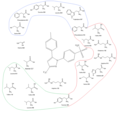Discovery and development of cyclooxygenase 2 inhibitors
Discovery and Development of Cyclooxygenase 2 Inhibitors
The discovery and development of cyclooxygenase 2 (COX-2) inhibitors mark a significant milestone in the field of pharmacology and medicine. These drugs, also known as COX-2 selective inhibitors, are a form of nonsteroidal anti-inflammatory drug (NSAID) that directly target the COX-2 enzyme, responsible for inflammation and pain. This article outlines the journey from the discovery of the COX-2 enzyme to the development of COX-2 inhibitors, highlighting the scientific, medical, and commercial impacts of these drugs.
Discovery of Cyclooxygenase[edit]
The story of COX-2 inhibitors begins with the discovery of the cyclooxygenase (COX) enzyme. In the early 1970s, researchers identified COX as the enzyme responsible for the synthesis of prostaglandins, which play a key role in inflammation, pain, and fever. Initially, it was believed that there was only one form of the COX enzyme. However, in the early 1990s, a second form, named COX-2, was discovered. Unlike COX-1, which is expressed in most tissues and involved in physiological functions, COX-2 is primarily induced during inflammation.
Development of COX-2 Inhibitors[edit]
The identification of COX-2 as a separate enzyme sparked interest in developing drugs that could inhibit this enzyme specifically, without affecting COX-1, thereby reducing the gastrointestinal side effects associated with traditional NSAIDs. The first COX-2 inhibitor, celecoxib (Celebrex), was approved by the FDA in 1998, followed by rofecoxib (Vioxx) and valdecoxib (Bextra).
Clinical Applications[edit]
COX-2 inhibitors were designed to provide anti-inflammatory and analgesic effects similar to traditional NSAIDs but with a lower risk of gastrointestinal issues. They have been used in the treatment of various conditions, including osteoarthritis, rheumatoid arthritis, acute pain, and dysmenorrhea.
Controversies and Safety Concerns[edit]
Despite their initial success, COX-2 inhibitors faced significant safety concerns. In 2004, rofecoxib was withdrawn from the market due to an increased risk of cardiovascular events. This led to a re-evaluation of the safety profile of all COX-2 inhibitors and stricter regulations by drug authorities.
Current Status and Future Directions[edit]
Today, COX-2 inhibitors remain an important class of drugs, with ongoing research aimed at developing safer and more effective COX-2 selective inhibitors. The discovery and development of COX-2 inhibitors have also paved the way for further research into the COX pathway and its role in disease.
-
Discovery and development of cyclooxygenase 2 inhibitors
-
Discovery and development of cyclooxygenase 2 inhibitors
-
Celecoxib structure
-
Parecoxib structure
-
Valdecoxib structure
-
Etoricoxib structure
-
Lumiracoxib structure
-
Rofecoxib structure
Ad. Transform your life with W8MD's Budget GLP-1 injections from $75


W8MD offers a medical weight loss program to lose weight in Philadelphia. Our physician-supervised medical weight loss provides:
- Weight loss injections in NYC (generic and brand names):
- Zepbound / Mounjaro, Wegovy / Ozempic, Saxenda
- Most insurances accepted or discounted self-pay rates. We will obtain insurance prior authorizations if needed.
- Generic GLP1 weight loss injections from $75 for the starting dose.
- Also offer prescription weight loss medications including Phentermine, Qsymia, Diethylpropion, Contrave etc.
NYC weight loss doctor appointmentsNYC weight loss doctor appointments
Start your NYC weight loss journey today at our NYC medical weight loss and Philadelphia medical weight loss clinics.
- Call 718-946-5500 to lose weight in NYC or for medical weight loss in Philadelphia 215-676-2334.
- Tags:NYC medical weight loss, Philadelphia lose weight Zepbound NYC, Budget GLP1 weight loss injections, Wegovy Philadelphia, Wegovy NYC, Philadelphia medical weight loss, Brookly weight loss and Wegovy NYC
|
WikiMD's Wellness Encyclopedia |
| Let Food Be Thy Medicine Medicine Thy Food - Hippocrates |
Medical Disclaimer: WikiMD is not a substitute for professional medical advice. The information on WikiMD is provided as an information resource only, may be incorrect, outdated or misleading, and is not to be used or relied on for any diagnostic or treatment purposes. Please consult your health care provider before making any healthcare decisions or for guidance about a specific medical condition. WikiMD expressly disclaims responsibility, and shall have no liability, for any damages, loss, injury, or liability whatsoever suffered as a result of your reliance on the information contained in this site. By visiting this site you agree to the foregoing terms and conditions, which may from time to time be changed or supplemented by WikiMD. If you do not agree to the foregoing terms and conditions, you should not enter or use this site. See full disclaimer.
Credits:Most images are courtesy of Wikimedia commons, and templates, categories Wikipedia, licensed under CC BY SA or similar.
Translate this page: - East Asian
中文,
日本,
한국어,
South Asian
हिन्दी,
தமிழ்,
తెలుగు,
Urdu,
ಕನ್ನಡ,
Southeast Asian
Indonesian,
Vietnamese,
Thai,
မြန်မာဘာသာ,
বাংলা
European
español,
Deutsch,
français,
Greek,
português do Brasil,
polski,
română,
русский,
Nederlands,
norsk,
svenska,
suomi,
Italian
Middle Eastern & African
عربى,
Turkish,
Persian,
Hebrew,
Afrikaans,
isiZulu,
Kiswahili,
Other
Bulgarian,
Hungarian,
Czech,
Swedish,
മലയാളം,
मराठी,
ਪੰਜਾਬੀ,
ગુજરાતી,
Portuguese,
Ukrainian








